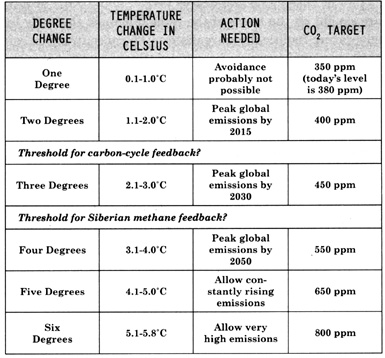 Mark Lynas reports in his introduction to Six Degrees: Our future on a hotter planet that
Mark Lynas reports in his introduction to Six Degrees: Our future on a hotter planet that As we come toward Earth Day, I admit to some sympathy with the folks in the bathroom. I haven't been so gripped by a dystopian vision since reading Jonathan Schell's Fate of the Earth some years ago. But we haven't done in the species with nukes yet, so just perhaps we can also evade some of the worst effects of the grand experiment in accelerated planetwide climate change we set loose through our innocent, thoughtless, greedy exploitation of our only home....I overheard a conversation in the restroom after one event in which one audience member apologized to another for dragging them out to something so depressing. I was truly shocked. Depressing? It had honestly never occurred to me that Six Degrees might be depressing. Yes, the impacts presented are terrifying -- but they are also, in the main, still avoidable. Getting depressed about the situation is now is like sitting in your living room and watching the kitchen catch fire and then getting more and more miserable as the fire spreads throughout the house -- rather than grabbing an extinguisher and dousing the flames.
Lynas's project is simple. He has read the massive accumulation of scientific papers now in circulation about particular probable effects of global warming and brought them together in narrative descriptions of what the world will be like as it warms from one to six degrees Celsius (roughly warming over a range of 1.8 degrees to 13 degrees Fahrenheit). The news is bad. Very bad. The few of us humans still around in a six degrees Celsius warmer world would be lonely, hungry and chronically terrified of catastrophe.
I'll pull out some particular scientific predictions recounted by Lynas that apply to where I live, California.
- At one degree of warming (virtually accomplished today), the entire Great Plains agricultural region of the United States will be prone to perennial drought leading to permanent conditions like the Dust Bowl in the 1930s. In California we'll have to pick up some of the people and some of the slack in food growing -- while our own water shortages worsen.
- At two degrees, a couple of centuries of water engineering in California that have made the underlying desert bloom will reach the end of their capacity to hide water scarcity. We'll be
on a collision course between a burgeoning population and a declining water supply as the world warms. One major study ... projected declines of between a third and three-quarters in a two degree world. In addition, heat waves in Los Angeles will quadruple in frequency, while crippling droughts will occur 50 percent more often, increasing the demand for scarce water. With Sierra Nevada snowpack declining and earlier melt producing earlier spring runoff, surface water supplies to 85 percent of Californians, orange growers and city dwellers alike, will be reduced.
...the likelihood of winter flooding will also increase, even while reduced runoff causes water shortages in the summer. Most affected by increased floods will be the mountainous regions of the California Coastal Range and the Sierra Nevada.... In addition summer droughts mean forests becoming tinder dray and increasingly susceptible to wildfires.
...the changes in snowpack and runoff will not just mean that golf courses and ski resorts bite the dust. They call into question the whole region's capacity to support big cities and agricultural areas. California will no longer be the Golden State once global warming begins to bite.
- In a three degree Celsius warmer world, the melting Artic will change weather patterns further. Low pressure systems that now blow in off the Pacific and dump rain on California will move north as Artic ice melts to open water. Scientists project 30 percent less winter rain fall. In these conditions, Forest Service scientists based at the Lawrence Berkeley lab project 50 percent more out of control wild fires in the San Francisco Bay Area -- and 125 percent more on the slopes of the Sierra Nevada.
As summer droughts dry out grassland and forest, people will wait for that single spark that will set their world aflame. Fire crews may arrive, but their trucks will be empty and their hoses useless. There will be nothing to stop the burning.
- In a five degree warmer world, ninety percent of California's snowpack is gone -- there simply isn't any water in most of the state.
Okay, all this is scary as hell. Can we avert it? According to Lynas, maybe.

Click for a larger image of Lynas's chart.
The key to his prescription for us -- worldwide, collectively -- is not to allow carbon dioxide concentrations to exceed 400 ppm (parts per million) which would stabilize the climate at not more than 2 degrees warming and give us a chance of pick up after the mess we've made. We stand at 385 ppm now. We probably have less than 10 years to avert the most drastic parts of this forecast.
Does the species choose to fry? Apparently we can't avoid having an opportunity to find out.
No comments:
Post a Comment